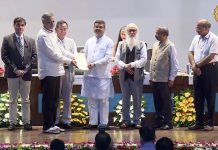Bhubaneswar: Kumbh Mela symbolises a special aspect of Hinduism that is rarely discussed. It is not about any temple, deity, devotion, song but a tradition where your whole body is covered with the holy ash ( Bibhuti/ Bhasm), the tangled hair clots on the head, and holding a measurement in hand the powerful , naked saints/ monks being various religious camps are prominently have been visualized. They are the followers of the Natvar Lord Shiva. This Mela is an auspicious inclusion which has nothing to do with any meditation and thought process. Here, one has to take dip in a particular river, at a particular time at a particular place. This bath is completed after the saints take their dips here. One can argue that as there is an involvement of the body, it is connected to Tantrism.
There are many such religious inclusions conducted in different parts of India where the saints, monks with a body covered with ashes come together. Possibly, these saints have been created in the previously called the Terai region and later came from the Western Panjan in 1000 BC to oppose the Vedic culture then. There was a conflict between them in Haridwar which is mentioned in our history. First it was scripted in the Mahabharat where Lord Shiva had slitted the head of King Dakhya. These ascetics were known as the Skull – bearers, Skull- men, and lord of the animals. They have been transformed with the passage of time. They have become saints and influenced by Shaivasm, Vaishnavism and Sikhism. Now they are called the Naga Sadhus. The calendar of the ascetics who roam around and visit places used to be determined as per the movement of the moon ( every month), Sun (every year), and Jupiter ( every 12 years). When Jupiter is placed in Aquarius and Leo at the same time, then it is celebrated as Maha Kumbh in Haridwar and Sinhasta in Nashik. Later all the inclusions were called Kumbh and during British rule, after 1857 this festival was associated with the ‘nectar of immortality’ to safeguard the identity of the Hindus.
The religious arenas, ashrams and camps had started from the time of Shankaracharya. In the 8th century Shankaracharya played an important role in popularising Vedanta. He was opposing Buddhist principles. Later in the 13th century the stories against the visits of Aadi Sankar were scripted by the Brahmins and Pandits of the Vijayanagar empire. The emperor of Vijaynagar felt the danger towards the Hindus from the Turks from central Asia. Earlier the Huns, Shak and Kusans from central Asia had come to India not only for wealth but they wanted to change native culture. They started to establish ‘Turuk belief’ by opposing idol worship. They brought the practice of worshipping facing to the west in one community hall barring any caste. Now this practice is known as Islam.
The succession of warriors and ascetics in Hinduism is ancient in nature but it came to the forefront after the rise of the Islamic power around 1500 A.D. The spiritual songs, Sufi and the saints who loved spiritual music were the same. The Naga saints had kept the trade secured by using camels and were getting supported by the kings and the traders. These trades prominently happened on the banks of river Ganga ( Haridwar, Varanasi, Prayagraj and Ujjain) and river Godavari (Nasik).
In the 18th century these places of trades became the competitive spits between the weak Mughals and the powerful Marathas. The words like Shahi and Peshwai show the influence of the Persiann and Marathas. This culture is not very much visible in the southern regions.
Gentleness or observation of Brahmacharya is the utmost priority for an ascetic. But the importance of this principle seems to be wearing away. According to the saints from Buddhism and Jainism, Brahmacharya is not just about sacrificing family life. It is the main path to attain enlightenment and power. This power can only be achieved through spirituality , Brahmacharya and complete surrender. The power of chanting and minds can be ingrained within the brains through spines and be developed by deep meditation. These ascetics possessed so much power that they could walk in the water, fly in air, live among wild animals, and change their shapes. They could also control the minds of others. They were the real owners of extraordinary powers and wisdom. All these traditions are painted in the Tantrik Boudh Mala of Himalayas. The warriors and saints were possessed by great powers and the kings loved them, used them for increasing the military power of the kingdom.
These thoughts from the middle age are popular from the times of Shankaracharya. But it is neglected, ignored and even forgotten to a great extent in today’s time. The power of the warriors and saints remains in their souls. The ashes and pious Ubtans put on their body absorb these powers and wisdom and mix in the water during the holy bath. The river water becomes pious as a nectar that can change the health and fortune of a person. It Increases its power in the triveni sangam in the right alignment of stars and planets. The Kumbh Mela is concerned to the people, saints, monks, politics, insights, military and royalty. It is a gathering of energy displays of Hinduism. We can associate it with the Vedic terms Soul, Salvation and religion but it is more aligned to the inclusion of wisdom and power as per the Tantra scriptures.
-OdishaAge




















